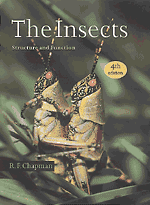Book contents
- Frontmatter
- Contents
- Preface
- Acknowledgments
- PART I The Head, Ingestion, Utilization and Distribution of Food
- PART II The Thorax and Locomotion
- 7 Thorax
- 8 Legs and locomotion
- 9 Wings and flight
- 10 Muscles
- PART III The Abdomen, Reproduction and Development
- PART IV The Integument, Gas Exchange and Homeostasis
- PART V Communication
- Taxonomic index
- Subject index
10 - Muscles
Published online by Cambridge University Press: 05 June 2012
- Frontmatter
- Contents
- Preface
- Acknowledgments
- PART I The Head, Ingestion, Utilization and Distribution of Food
- PART II The Thorax and Locomotion
- 7 Thorax
- 8 Legs and locomotion
- 9 Wings and flight
- 10 Muscles
- PART III The Abdomen, Reproduction and Development
- PART IV The Integument, Gas Exchange and Homeostasis
- PART V Communication
- Taxonomic index
- Subject index
Summary
STRUCTURE
Basic muscle structure
Each muscle is made up of a number of fibers, which are long, usually multinucleate cells running the whole length of the muscle. The characteristic feature of muscle fibers is the presence of myofibrils (fibrils) which are embedded in the cytoplasm (sarcoplasm) and extend continuously from one end of the fiber to the other. The fibrils in their turn are composed of molecular filaments consisting mainly of two proteins: myosin and actin. These filaments are much shorter than the whole muscle and they are arranged in units called sarcomeres. Each fibril comprises a large number of sarcomeres stacked end to end (Fig. 10.1a,b).
The thick (myosin) filaments are stouter and are made up of numerous myosin molecules. These are elongate structures with two globular ‘heads’ at one end, and, in each sarcomere (see below), all the molecules in one half are aligned in one direction, while all those in the opposite half are aligned in the opposite direction (Fig. 10.1c). The myosin molecules are probably arranged round a core of another protein, paramyosin, with their heads arranged in a helix.
The thick filaments are each surrounded by a number of thin (actin) filaments which consist of two chains of actin molecules twisted round each other. The actin filaments are oriented in opposite directions at either end of the sarcomere and those of adjacent sarcomeres slightly overlap each other and are held by an amorphous material.
- Type
- Chapter
- Information
- The InsectsStructure and Function, pp. 229 - 256Publisher: Cambridge University PressPrint publication year: 1998
- 2
- Cited by



